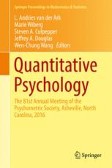Search
Search Results
-
Causal Inference in Longitudinal Network-Dependent Data
Much of the existing causal inference literature focuses on the effect of a single or multiple time-point intervention on an outcome based on...
-
Science and Society: A Reflexive Approach to Official Statistics
In this chapter, we open a large box with questions and reflections about the scientific background of official statistics. First, it will be about...
-
LTMLE with Clustering
Breastfeeding is considered best practice in early infant feeding, and is recommended by most major health organizations. However, due to the...
-
Estimation of Causal Effect Measures in the Presence of Measurement Error in Confounders
The odds ratio, risk ratio, and the risk difference are important measures for assessing comparative effectiveness of available treatment plans in...

-
Generalized inverse-Gaussian frailty models with application to TARGET neuroblastoma data
A new class of survival frailty models based on the generalized inverse-Gaussian (GIG) distributions is proposed. We show that the GIG frailty models...

-
Tips for Six Sigma Sponsors to Support Projects and the Program
This chapter is aimed at Sponsors of Six Sigma projects, with a short summary on Six Sigma, basic recommendations for the management, the focus of...
-
Introduction
A short introduction to bilinear regression analysis is presented. The statistical paradigm is introduced. Moreover, bilinear regression models are...
-
Causal Inference with Observational Multilevel Data: Investigating Selection and Outcome Heterogeneity
Causal inference with observational data is challenging, as the assignment to treatment is not random, and people may have different reasons to...
-
On edited archives and archived editions
Building on a longstanding terminological discussion in the field of textual scholarship, this essay explores the archival and editorial potential of...

-
A Monte Carlo subsampling method for estimating the distribution of signal-to-noise ratio statistics in nonparametric time series regression models
Signal-to-noise ratio (SNR) statistics play a central role in many applications. A common situation where SNR is studied is when a continuous time...

-
Discrete Random Variables and Probability Distributions
Suppose a city’s traffic engineering department monitors a certain intersection during a one-hour period in the middle of the day. Many...
-
Designing and Modeling Capture–Recapture Experiments
In designing a capture–recapture experiment, a substantial check list of questions that need answers is provided, as well as references to other...
-
Causal Measures of the Treatment Effect Captured by Candidate Surrogate Endpoints
In randomized clinical trials, true clinical endpoints that are rare or difficult to measure can be costly and time consuming. Therefore, there is an...

-
Aspects of Quantum Theory
The basic formalism of quantum theory is reviewed and put into my setting. In particular, spin and angular momentum are considered, and also...
-
Efficient Circular Cross-over Designs for Models with Interaction
Cross-over designs are widely used in many areas such as clinical trials or agricultural field experiments. In addition to the effect of the...
-
Analytical properties of generalized Gaussian distributions
The family of Generalized Gaussian (GG) distributions has received considerable attention from the engineering community, due to the flexible...

-
Strengthening Instrumental Variables Through Weighting
Instrumental variable (IV) methods are widely used to deal with the issue of unmeasured confounding and are becoming popular in health and medical...

-
Semiparametric Theory and Empirical Processes in Causal Inference
In this paper we review important aspects of semiparametric theory and empirical processes that arise in causal inference problems. We begin with a...
-
Big Data and Neuroimaging
Big Data are of increasing importance in a variety of areas, especially in the biosciences. There is an emerging critical need for Big Data tools and...

-
Estimation of causal effects in observational studies with interference between units
Causal effects are usually estimated under the assumption of no interference between individuals. This assumption means that the potential outcomes...
